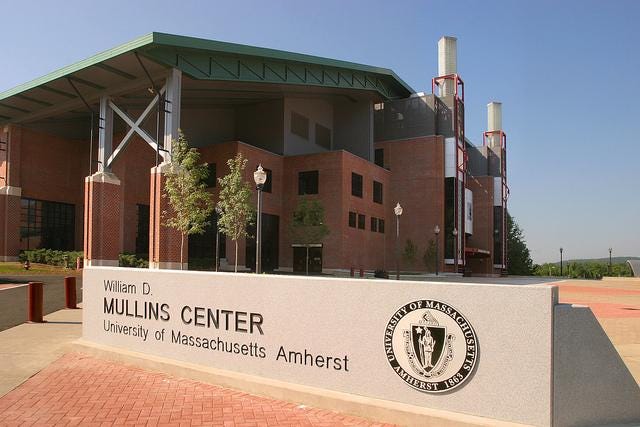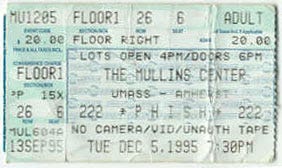SET 1: Horn > Chalk Dust Torture, Taste That Surrounds, The Lizards, Free, Esther > David Bowie, I'm Blue, I'm Lonesome
SET 2: Poor Heart > Bathtub Gin -> Keyboard Army, Scent of a Mule > Jam > Lifeboy, Harry Hood, Cavern
ENCORE: Theme From the Bottom, Sweet Adeline
I haven’t found a ton of band interviews from Fall 95, where the intense travel and scant days off didn’t leave much time for taking phone calls from local music critics asking “So, are you the new Grateful Dead?” But with the rare two-day run in Amherst, at least one Q&A found the time to happen — though it wasn’t with a band member, precisely. Before night 2 at UMass, Dean Budnick, 12/2/95 chess move maker and current editor-in-chief of Relix, interviewed Phish lighting director Chris Kuroda about his work for phish.net/rec.music.phish, back when they were each as much of an email list as a website.
It’s a pretty fascinating perspective on the state of the Phish from the POV of the lighting board. The always practical Kuroda talks about specific shows over the years that he liked or found challenging and covers several themes that have come up on our essay voyage and assorted other minutia: the difficulties of adjusting on the fly for venues of wildly different sizes and types, the removal of the Minkin backdrop, the new practice of officially videotaping shows, the health benefits of the “mineral oil fog” they use to enhance the lights, and the increasing irrelevancy of their pre-prepared setlist:
A set list is no help because the band will literally sit in there for an hour and a half in their dressing room and formulate a set list, think about it, how they want the show to go, what would go good after this, then walk on stage and not play a single tune, not one. They won't even open with the first song, so it's pointless.
You don’t really get the sense from Kuroda that Phish (and their crew) felt like the band was reaching a creative peak; the slow, steady growth in popularity of the band appears to have sanded off any such hyperbolic proclamations. He’s mostly just thrilled that they’ve reached the scale they have, playing venues where Kuroda saw the Dead (Hampton), interesting old buildings (Hershey), and most importantly to him, rooms big enough to install his full, ever-expanding light rig without a whole mess of pre-show, on-the-fly modifications.
The band’s larger improvisational risks get about half a sentence/thought; Budnick asks about lighting the SPAC Disease > Free, Kuroda shrugs “I'm just making it up as I go along.” He’s more verbose about how he tries to set the mood with color during different parts of the show and within particular songs, setting up the increasingly longform narrative structure of sets to come.
The entire show is based on mood in my opinion. You always see a nice cool pleasant look at the beginning of the Harry guitar solo, you won't see bright orange-red, hot. Speaking of Harry, before we had the strobes, the part where I normally strobe now in Harry, something like that would have been red, hot. Antelope jams are red but Reba jams start out nice and blue. That kind of thing. I'm very particular about trying to put the right mood out there for everything that goes on on-stage, in my opinion.
They’re not painting full-show landscapes together yet, but Amherst Night 2 is definitely a show where Phish kept their light maestro on his toes. The first set is another hodgepodge like the night before, but the second hangs on two monumental jams and some strange moments that would drive any normal LD straight from the board into the asylum, such as the brief accelerating heavy metal jam that launches straight out of Mule without warning and somehow finds its way to Lifeboy, of all things.
But the main events are Bathtub Gin and Hood, the two big jams that the previous night was missing. The Gin is by several minutes the longest version of the song ever played to that point, and it gets there in uncharacteristically patient fashion, unlike the manic channel-hopping of Murat ‘93 or a month ago at the Fox. It just rolls along for 23 minutes, never changing key or dropping teases (apart from a very subtle DEG around the 7th minute), Mike and Page nudging it every so often in interesting directions, including a Latin jazz fusion section Chick Corea would endorse from 13:00 through Trey’s obligatory mini-kit session. In a month known for its blistering jams, it’s remarkably deliberate.
Deliberacy is usually Harry Hood’s bag, but tonight’s sets a brisk pace, moving quickly through the intro and flying through the composed section. The jam is also frisky and melodic, sounding more like a 92 version than its stargazey mature form. But along the build, it keeps steering in interesting directions — the heavily Leslie-fied 9th minute, Trey and Fish staging another mini-battle in the 14th and 15th minutes, an abrupt ALO Hood-style pull back to twinkly starlight just before the final peak, right when Kuroda was probably about to call for those strobes.
Both jams represent an improvisational strategy I’m only now picking up on this time through the December shows. For most of their career, Phish is known for jams that travel long distances from their origin, modulating between keys or exploring several themes. December 95 jams...don’t really do that. They pick a key, start with an idea, and incrementally bat it around, sometimes for 15 minutes or more. In August 1993, jams would manically veer between teases and segues; by Fall 97 they’re constructing symphonic jams of two or three movements, each given several minutes to unfurl. But December 95 jams are monolithic, patient, direct. At worst, they can feel static; at best, they become subliminally hypnotic, ratcheting up the tension and intensity without any abrupt musical turns.
From where Kuroda’s sitting, that’s probably a welcome approach — he too can concentrate on a gradually evolving mood and thematic variations with his instruments of light instead of sound. For all parties involved, it’s probably a wise strategy for their first time around the arena circuit; do what you do best, just do it bigger. Three months into this tour, a dozen years into their career, it’s all reflex at this point, for Phish and their crew.
DB- So what are you thinking about during say a sick Antelope jam?
CK- I don't know, I'm just jamming. Not only that when it's over I can't even tell you what I just called to those guys. I'm in a zone, that's the only way I can describe it. It's an out of body experience in a sense, I'm a different human being. I don't know what I'm thinking or where I am, it just happens. That's the only way I can describe it, it's weird. And when it's done, it's draining because I'm mentally depleted every night. When a Phish show is over my brain is jello. I'm spacey, I can't concentrate on anything.
[Ticket stub from Golgi Project. Thanks to Dean Budnick for the great interview 25 years ago!]





